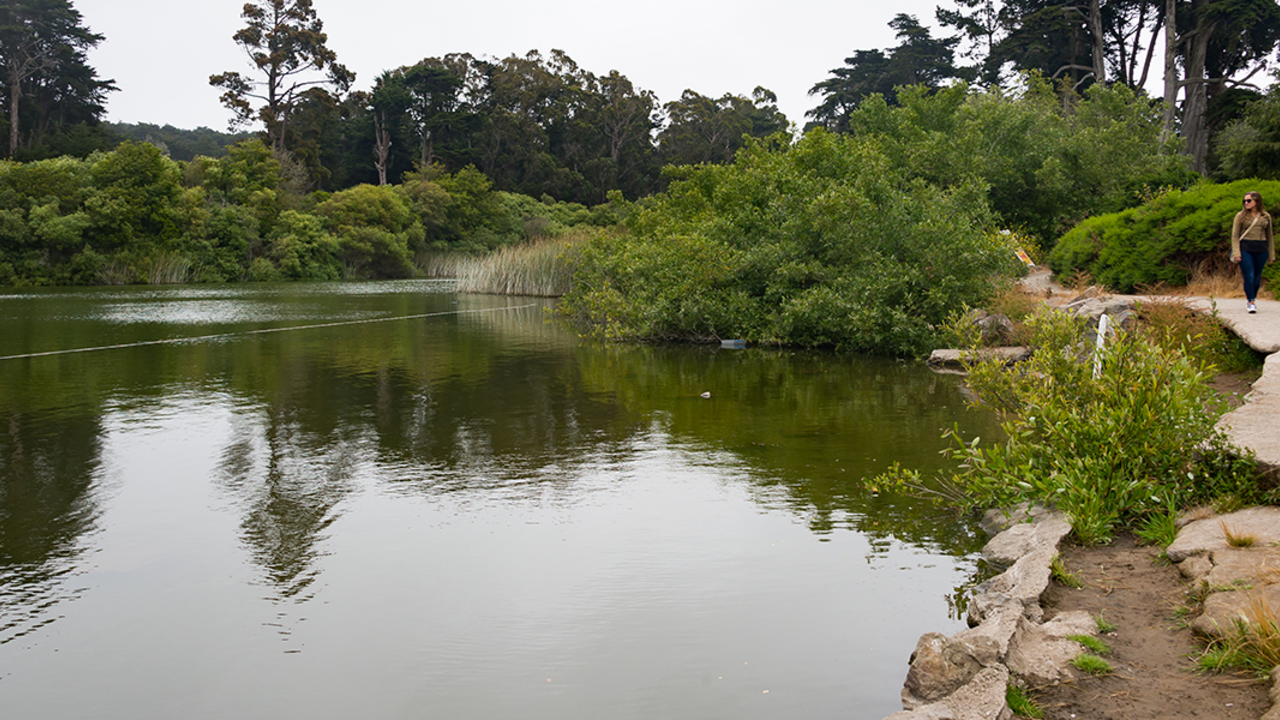Adventures with Stinky Plants: Part II

Alison Taggart-Barone/Parks Conservancy
Did you know that there are wildflowers that grow, often totally unnoticed by humans, underwater? That’s right—there are plants that can grow, flower, and even pollinate below the water’s surface.
Many of these underwater blossoms are “living fossils,” belonging to the most ancient groups of flowering plants. Others are grassy plants that have more recently adapted to living in the water. They aren’t all closely related, but what these submerged plants have in common is that they’re incredibly important to the health of aquatic ecosystems.
Last fall, seed ecologist Michelle Laskowski wrote a Park E-ventures article about collecting submerged aquatic vegetation (SAV) for the restoration and enhancement of Mountain Lake. When she last left off, several species of stinky, slimy, underwater plants had been collected and were on their way to their new home at the Presidio Native Plant Nursery. The nursery had never grown aquatic plants before, and it was a learning process for everyone involved.
Now, we have a small but flourishing aquatic plant area at the nursery. We’re successfully growing seven species of SAV, and despite not knowing much going into this project, we’ve managed to keep our “stinky plants” alive and thriving.
As the SAV intern, I’m part of a large team of folks led and supported by the Presidio Trust (in partnership with the Parks Conservancy and National Park Service), who are working to restore native plant life to Mountain Lake. Along with the occasional jaunt in a kayak, studying and growing these plants in the nursery is a big part of my position.
Luckily, it turns out that growing SAV in the nursery isn’t all that hard, even though it is quite different from growing land plants. SAV need many of the same things terrestrial plants need—water, carbon dioxide, sunlight, and nutrients—but they get those things in different ways. For example, I never have to worry about irrigation, since these plants already grow underwater! Instead of being grown in deep pots on greenhouse tables, these plants are grown in shallow flats in big barrels of water.
Potting mix isn’t part of the picture, either. Whereas many terrestrial plants draw nutrients from their roots in the soil, SAV only use their roots as anchors (and they don’t even root that deeply). So, while our land plants are grown in a nutrient-rich potting mix, aquatic plants dig their roots into a thin layer of nutrient-poor clay.
Instead of battling weeds, I battle algae. But, instead of removing the algae myself, I enlist native mollusks like mussels and snails to gobble up the algae. By creating the right balance of native plants and animals, each SAV tank at the nursery becomes its own mini-ecosystem. Once that system is healthy, growing SAV becomes a lot easier. It’s a relaxing, eye-opening activity, a bit like Zen gardening—but underwater.
We do run into some challenges, however. Even though we’ve learned a lot through trial, error, and research, we still haven’t ironed all the wrinkles out. Raccoons love to play in the SAV tanks, and keeping them from tearing up the mosquito netting over the tanks took a lot of work (and help from a carpentry wizard).
Identifying all of the animals that have hitchhiked on the plants we’ve gathered from the field is also really tough. I don’t want to accidentally introduce unknown creatures to Mountain Lake, so I enlist the help of local scientists to help sort out the different animals. It takes a lot of different brains and skills to keep this project going!
If you’ve never thought about submerged plants before, you aren’t alone. These plants aren’t terribly obvious, hidden in their underwater homes, and they aren’t conventionally good-looking—or good-smelling! Our dune scrub and chaparral communities have plenty of rare and beautiful native plants, but SAV are the tough cosmopolites of the plant world. Many species have global distributions, and some submerged plants can be so successful that people consider them pests.
It’s easy to ignore SAV, but when human action leads to these plants being depleted, we definitely feel the impact. SAV is incredibly important to our watersheds, providing valuable services to ecosystems and human communities alike. Underwater plant life stabilizes banks, calms waves and storm surges, filters stormwater runoff, controls algae, and provides food and shelter for wildlife. Restoring SAV is important not just for the health of wildlife, but for the health of our watersheds and neighborhoods. So, next time you see some wispy fronds below the surface, try to appreciate those understated blossoms and slimy leaves—and say thank you!
By Finn Black
Submerged Aquatic Vegetation (SAV) Intern